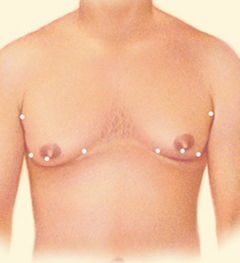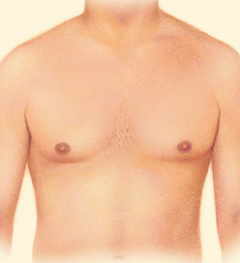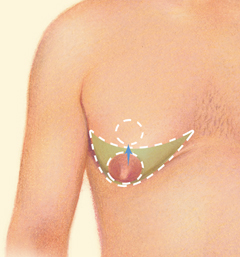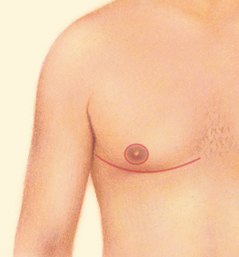- Male Breast Reduction Overview
- Am I a Candidate for a Male Breast Reduction?
- Your Welcoming Visit
- Getting Ready for Your Surgery
- The Location of Your Surgery
- Anesthesia
- The Surgery
- Surgical Complications
- Post-Operative Course
- Feeling Normal Again
- Your New Appearance
- Contact Richmond Aesthetic Surgery
Male Breast Reduction Overview
Beginning in puberty and persisting throughout life, many men are affected with a large, disproportionate chest. However, most of the time this excess breast development will spontaneously resolve, giving a normal shape and size. For those men that continue to have significant breast development, male breast reduction surgery (gynecomastia surgery) is a great option to correct this problem.
Gynecomastia (development of the male breast) can be caused by many different factors. The good news is that gynecomastia is benign and not cancerous. Certain over-the-counter and prescription medicines (Tagamet, Spironolactone) and specific illegal drugs (marijuana, anabolic steroids) have been linked to causing gynecomastia. Also, hormonal imbalances and overproduction of certain body chemicals may also lead to breast development in men. However, the overwhelming majority of cases have no specific cause that can be found.
Gynecomastia can affect a man’s self-esteem and change the way that he works, wears clothes, and lives. Gynecomastia can severely affect a man’s self-esteem and a sense of manhood. For these reasons Dr. Zemmel offers several procedures that will recontour the chest and pectoral area in men. The procedure may include liposuction to remove fatty tissue from the chest or an excisional breast reduction where skin, fatty tissue, and breast tissue are removed. Regardless of the approach that Dr. Zemmel utilizes, the goal is to get you back to feeling more like yourself again.
Am I a Candidate for a Male Breast Reduction?
Any male that has large and disproportionate breasts compared to their body may be a good candidate for this breast surgery. Your surgeon will assess how long you have had gynecomastia, any recent weight changes, and your physical appearance.
Before you decide to have surgery, think carefully about your expectations and discuss them with your surgeon at Richmond Aesthetic Surgery. A complete fee schedule of all charges related to the procedure will be given at the time of your initial consultation.
Your Welcoming Visit
During your initial consultation, your plastic surgeon will evaluate your chest, including the skin and underlying structures (muscle, bone, and fatty tissue quality), and discuss your goals for surgery and whether you are a candidate for a male breast reduction.
Your surgeon will check for medical conditions that could possibly cause large breasts. In addition, they may send you for laboratory or further medical studies. Ultimately, your surgeon will make sure that there is no underlying cause in your body that requires medical treatment to reverse your gynecomastia.
During your visit, Dr. Zemmel will assess any medical problems that may affect your surgery, such as uncontrolled high blood pressure, blood clotting problems, or the tendency to form excessive scars. Be sure to tell your surgeon if you smoke or are taking any drugs or medications, especially aspirin or other drugs that affect clotting.
Your surgeon will explain their technique, the anesthesia they will use, the facility where the surgery will be performed, the risks, and costs involved.
Do not hesitate to ask any questions you may have, especially those regarding your expectations and concerns about the results.
Getting Ready for Your Surgery
Your surgeon will give you specific instructions on how to prepare for surgery, including guidelines on eating and drinking, smoking, and taking or avoiding certain vitamins and medications. Following these instructions will help your surgery go more smoothly and ensure an uncomplicated recovery.
You should arrange for someone to drive you home after your discharge from the hospital and to help you out during that night.
The Location of Your Surgery
Dr. Zemmel performs gynecomastia surgery at St. Francis Hospital’s Ambulatory Surgical Center on an outpatient basis. Occasionally for large breast reductions, patients may be required to stay overnight in the hospital for monitoring. Your surgeon will let you know beforehand whether you will stay overnight.
After being discharged home, you will be seen within a few days after surgery to take the dressings down and see your new look!
Anesthesia
Dr. Zemmel performs all gynecomastia surgery under general anesthesia for safety and comfort concerns. Importantly, you will have a board-certified anesthesia doctor overlooking your surgery at St. Francis Hospital. Our surgeon performs all surgeries at St. Francis Hospital or St. Mary’s Hospital in Richmond, Virginia. This ensures that your surgery will be performed in an accredited facility with the highest level and safety standards.
The Surgery
During your initial consultation, your surgeon will discuss the different surgical treatment options available to you. The surgical technique chosen varies from patient to patient. Your surgeon will perform a complete exam of your chest to determine which procedure is optimal. Factors include:
- The size and shape of the breasts
- The quality and amount of excess skin
- The position and size of the nipple and areola
- The quality and amount of excess fatty tissue
- The presence of breast tissue
- The size of your ribs and breast bone
- The level of the crease (inframammary fold) beneath the pectoral muscle
One or two small liposuction cannula sites are the only incisions that will be made. Importantly, these are usually hidden in areas where they will not be seen (around the areola, in the breast fold). Liposuction can decrease the volume of tissue in your chest and give you a significantly improved smoother contour.


For patients who have a larger amount of breast tissue, more excess skin, or sagging of the nipple and areola, an excisional procedure may be necessary. In this case, it is not possible to remove the areas of dense, thick breast tissue, remove excess skin, or move the nipple higher with liposuction alone. A direct excision (or open procedure) is therefore required. This can be accomplished with several different incisional patterns depending on how much tissue requires removal:
- Periareolar Approach: Occasionally, a small incision will need to be made around half of the areola to remove tissue. This incision is small and will heal right into the natural boarder of the areola; fading away to being hardly, if at all, appreciable. This incision is used to remove subareolar tissue but not skin itself.
- Periareolar Reduction: If you have some excess skin, the skin will need to be removed during surgery. If there is a small amount of excess skin, liposuction will be performed first to give you the proper contour you deserve. Then a small amount of skin around your areola will be removed. By doing so, the size of your areola will be decreased to a more normal size and shape while removing the skin you do not need.
- Full Reduction: For those individuals who have a lot of extra skin, this will be removed through a more extensive surgery. Some people refer to this as the “keyhole” or “double incision” surgery. The skin and extra tissue will be removed from the fold by creating an incision that mimics the border of the pectoralis muscle. Your surgeon will also have to temporarily remove the areola and nipple and then replace it into its originally intended position as well as correct its aesthetic size and shape. Although this leaves a scar on both sides of your chest, it curves along the border of pectoralis muscle and is “camouflaged” as the edge of muscle.


Surgical Complications
When gynecomastia surgery is performed by qualified and trained plastic surgeon, such as Dr. Zemmel, complications are infrequent and usually minor.
These rare complications include: hematoma (a collection of blood under the skin that must be removed by the surgeon), injury to the nerves that control the pectoral muscles, infection, problems with skin loss and wound healing issues, fluid buildup (seromas), contour irregularities, scarring, and reactions to the anesthesia.
Dr. Zemmel will instruct you how to reduce your risks of complications before surgery and will provide you with a full set of instructions after surgery as well.
Post-Operative Course
There is some mild discomfort after surgery which is lessened with the pain medication prescribed. Some slight numbness of the skin is normal and usually disappears in a few weeks.
After surgery it is important to limit your activity. No strenuous activity or heavy lifting should be performed until you are cleared by your surgeon. However, you should ambulate frequently and walk about. If you had liposuction performed, then you will have to wear a chest compression garment.
You may shower the two days after surgery and clean your incisions. You will have skin glue on, therefore be gentle around the incisions when you clean them with soap and water.
Feeling Normal Again
Depending on the surgery that is performed, your downtime may be variable. One of the greatest benefits of liposuction for gynecomastia is the lack of downtime. You should be feeling almost like yourself within the first five to seven days after surgery. If a more extensive surgery is required, then it may take ten or more days to feel completely normal again. Your surgeon will give more specific guidelines for gradually resuming your normal activities.
Your New Appearance
After surgery you will be able to see your immediate results and appreciate the contour of the chest you deserve. Because Dr. Zemmel tailors his surgeries to your specific body, he individualizes each procedure to give you the best outcome possible.
Contact Richmond Aesthetic Surgery
If you would like more information on male breast reduction and treatment for gynecomastia, or if you would like to schedule a confidential consultation, please contact Richmond Aesthetic Surgery.